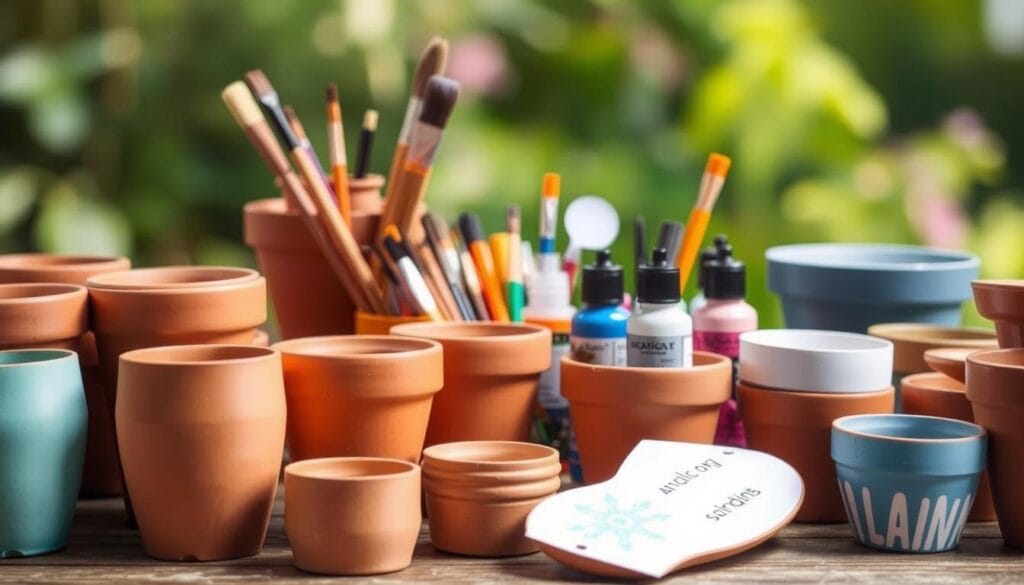The first time we tried natural Easter egg decorating, it was a family event. We chose not to use store-bought kits with fake colors. Instead, we used items from our kitchen to color the eggs. It was an eye-opener. The eggs turned out beautiful and the activity was eco-friendly. It felt special and full of meaning.
Using simple items like beets, turmeric, and red cabbage, we started a new tradition. Watching the eggs change colors was exciting. Using natural items made it feel safe. This activity wasn’t just about making pretty eggs. It was about having fun and experimenting as a family. Let’s get into natural Easter egg decorating. It’s easy and more enjoyable than you might think!
The Benefits of Decorating Easter Eggs with Natural Dyes
Decorating Easter eggs with natural dyes is now more common. This is due to its many advantages. One major benefit of natural dyes is avoiding synthetic chemicals. It’s better for families, especially those with young kids. This makes Easter more eco-friendly and helps the environment.
Using natural items like veggies and spices is also cheap. You can use things like beets, turmeric, and red cabbage. This not only saves you money but also uses up food scraps, helping the planet.
Another plus is how fun and sensory the process is. Boiling and mixing natural stuff adds great smells and textures. Kids can learn about nature and its many uses, making this both fun and educational.
Dyeing eggs this way is one of the safe Easter activities. It avoids preservatives and bad chemicals found in store-bought dyes. It also means eating an egg with a bit of dye on it is safe. Plus, how long you soak the eggs changes their colors. This can give you many different shades to play with.
This way of dyeing eggs creates lasting memories for your family during Easter. Below is a table with some natural items and the colors they make:
| Ingredient | Color | Soaking Time |
|---|---|---|
| Red Onion Skins | Red | Overnight |
| Beets | Pink (white eggs), Maroon (brown eggs) | 30 minutes to Overnight |
| Turmeric | Yellow | 30-60 minutes |
| Red Cabbage | Light Blue to Indigo | 30 minutes to Overnight |
| Red Wine | Burgundy or Purple | Overnight |
| Coffee | Light Brown (leftover coffee), Dark Brown (brown eggs) | 30 minutes to Overnight |
Essential Kitchen Ingredients for Natural Easter Egg Dyeing
Are you ready to decorate Easter eggs? We need some kitchen items for natural dyeing ingredients. It’s fun to learn that stuff we have can become beautiful dyes. With these, you can make bright colors in a safe, green way!
First up, onion skins. You will need about 4 cups, from 12 onions. Boiling eggs with these skins for 30 minutes makes a nice sienna color.
To get a bold red dye, use beets. You need 4 cups of chopped beets. Your eggs will turn light pink after soaking for 30 minutes in beet juice. For darker red, leave them in overnight.
Red cabbage makes great blues. It takes 4 cups of chopped cabbage. Soak eggs in this overnight for a beautiful royal blue.
Turmeric gives us yellow shades. You need 3 tablespoons of it. Boiling eggs in turmeric for 30 minutes makes deep gold. A 30-minute soak gives pale yellow.
Don’t forget coffee! One quart of it gives dark brown when boiled. For a soft light brown, soak eggs in cool coffee.
These DIY dye ingredients make Easter fun for everyone. Doing this together is a great kitchen adventure!
Step-by-Step Guide to Making Homemade Easter Egg Dyes
Are you ready to make some awesome Easter egg colors from your kitchen? You’re in the right spot! We’ll go through how to make natural Easter egg dye. 🌱 You just need a few simple items and patience. Let your eggs soak up those vibrant colors. Here’s how you can make your own Easter egg dyes with things from your pantry.
Creating Red Dye with Beets
We’re aiming for a bright red-pink color here. Start with 4 cups of water and heat till it boils. Add 4 cups of chopped beets—about three beets in total. Let it cook for 30 minutes, then take out the beets. You’ll get a strong red dye this way.
For every cup of dye, mix in 1 tablespoon of white vinegar. Put your eggs in this dye and leave them overnight. This makes the color really bright.
Making Yellow Dye Using Turmeric
For a sunny yellow dye, start with 4 cups of water. Heat it till it boils and add 3 tablespoons of ground turmeric. Cook for 15 to 30 minutes to get a bright yellow color.
Take out the turmeric bits, then add 1 tablespoon of white vinegar per cup of dye. Dip your eggs in the turmeric dye for at least 30 minutes. Leaving them overnight gives a stronger yellow. This is an easy and effective way to dye Easter eggs.
How to Achieve Blue with Red Cabbage
Red cabbage makes your Easter eggs turn blue, surprisingly. Start with 4 cups of water and 3 cups of chopped red cabbage. Heat until boiling, then let it simmer for 30 minutes. The dye looks purple at first, but that’s okay!
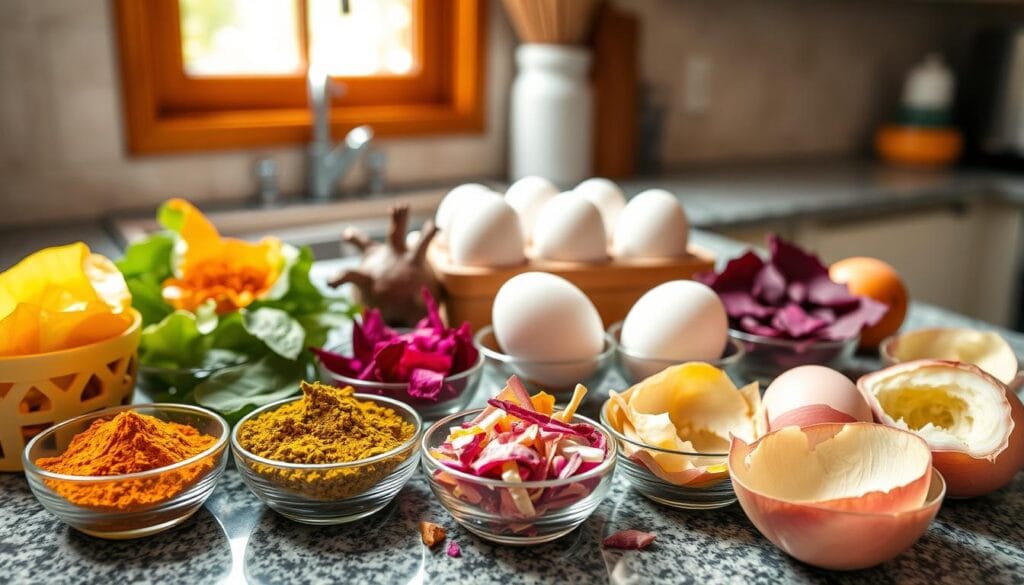
After removing the cabbage, you’ll have purple liquid. For every cup, add 1 tablespoon of vinegar. Put your eggs in and see them turn blue overnight. Using red cabbage is a magical way to color Easter eggs.
- Preparation: Start with 4 cups of water for each dye.
- Ingredient Proportion: Use about ½ to 1 cup of chopped vegetable per cup of water.
- Boiling: Simmer the mixture for around 15 to 30 minutes. Expect the volume to reduce slightly.
- Vinegar Addition: For each cup of dye, add 1 tablespoon of white vinegar.
- Soaking Time: Let the eggs soak overnight for the deepest color results.
This guide helps make sure your homemade Easter egg dyes look amazing. They’re also fun and safe for everyone. Happy decorating!
Unique Easter Egg Coloring Ideas with Kitchen Scraps
Want a new twist on coloring Easter eggs? Explore sustainable Easter egg decoration with kitchen leftovers! This approach cuts down on waste. Plus, it creates stunning, one-of-a-kind egg colors for your festivities.
Experimenting with Onion Skins
Don’t throw away those onion skins yet! They can become amazing dyes. With onion skins, your eggs can turn from golden to deep maroon. Boil the skins with some vinegar in water for 20-30 minutes. Then, dunk your eggs in for 20 minutes to a few hours to get the shade you like.
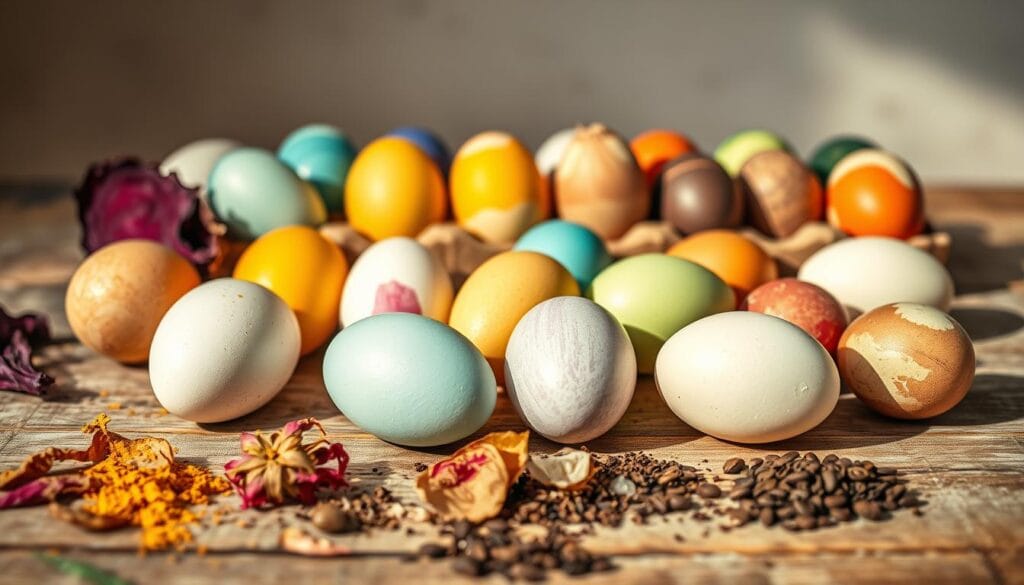
Using Red Wine for Burgundy Shades
Got red wine? Use it for a rich burgundy color. This unique egg dyeing idea adds elegance to your decor. Just like with onion skins, boil the wine for 20 minutes, add vinegar, and soak your eggs. You’ll get beautiful, deep colors.
Crafting Green Dye by Combining Ingredients
For bright green, mix turmeric and cabbage. Use 1/4 cup turmeric for yellow and 2 cups chopped cabbage for blue. Simmer each in water with vinegar, then blend the dyes for green. This shows off your sustainable Easter egg decoration skills and creativity!
Using these Easter Egg Coloring Ideas with kitchen scraps makes your holiday green and special. Enjoy your dyeing!
Troubleshooting Common Issues with Natural Easter Egg Dyeing
You’re all set with your natural dyes, but the eggs aren’t looking right. No worries; we have tips to fix your Easter egg dye issues!
First, make sure your eggs are ready. Clean them with a gentle vinegar solution. This helps remove oils and lets the dye soak in better.
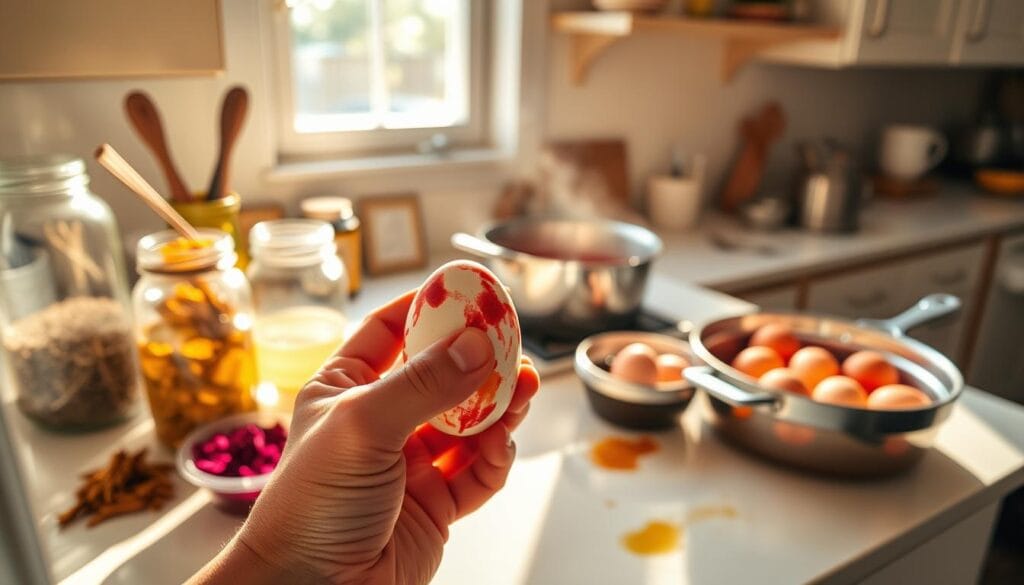
Seeing uneven colors? Your eggs might not be fully in the dye or moved around enough. Make sure your dye pots have enough liquid to cover the eggs. Here’s a guide to help with your dye baths:
| Color | Ingredients | Enhancements | Steeping Time |
|---|---|---|---|
| Blue | Purple cabbage or blueberries | Vinegar | 30 minutes+ |
| Red | Beet juice or pomegranate | Vinegar | 30 minutes+ |
| Yellow | Turmeric or saffron | Vinegar | 30 minutes+ |
| Green | Spinach or spirulina | Vinegar | 30 minutes+ |
| Purple | Grape juice | Soda ash | 30 minutes+ |
| Orange | Dyer’s chamomile | Citric acid or lemon juice | 30 minutes+ |
For lighter colors, try leaving the eggs in the dye longer. A tip: adding a spoonful of distilled white vinegar can help. Also, use enough dye stuff like half a bag of chamomile for yellow or a cup of berries for blue.
Keep in mind, natural dyes give soft pastel colors, softer than synthetic dyes. And most importantly, enjoy the process! 🥚🌈
Fun and Creative Techniques for Decorating Easter Eggs with Natural Dyes from Your Kitchen
We can turn plain eggs into amazing art with natural dye methods. It’s a fun tradition.
Wrap and Boil Method
This method lets you make unique Easter egg decorations. Just wrap eggs with onion skins or dyed cloths. When boiled, these eggs get cool patterns on them.

Below is a table showing how to get different colors with this method:
| Natural Dye Ingredient | Color on White Eggs | Color on Brown Eggs |
|---|---|---|
| Onion Skins | Orange | Brick Red |
| Ground Turmeric | Mustard Yellow | Golden Yellow |
| Chopped Purple Cabbage | Blue | Green |
Creating Patterns with Fresh Herbs
Try using fresh herbs for more artistic eggs. Place herbs on the eggs, then wrap in stockings. Dip these into any dye you like for a cool embossed effect.
Marbleizing with Onion Skin Bits
To get a marbled look, use onion skin bits. Wrap these bits and the egg in a cloth. You’ll get a beautiful marbled pattern this way.
These egg decorating ideas are not only unique but also safe. They use natural, non-toxic items from your kitchen. You can try wrap and boil, patterns with herbs, or marbleizing. Any way you choose, your eggs will look stunning.
How Long to Soak Your Eggs for Different Dye Intensities
When you start decorating eggs with natural dyes, the soaking times for egg dyes are key. They help you get just the right color, from soft pastels to bold shades. It’s all about the timing.
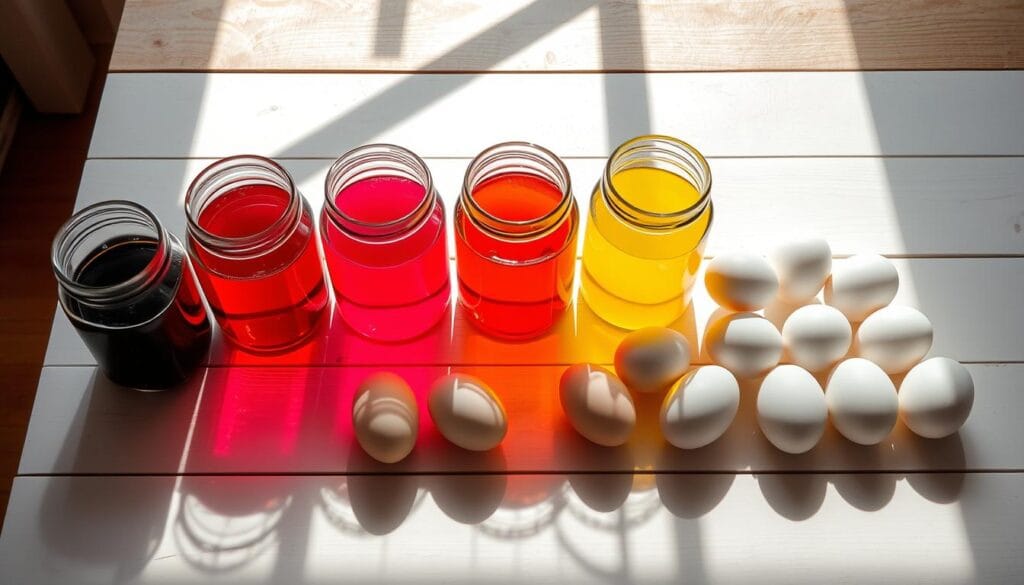
The color’s strength depends on how long you soak the eggs. A quick 5-minute soak gives light colors. But if you leave them for hours or even overnight, you’ll get deep, rich colors.
Let’s look at using blue dye from red cabbage. You need a cabbage head and 4-5 cups of water. A short soak makes light blue eggs. An overnight soak makes them deep blue. For bright red from beet dye, you soak the eggs longer in a mix of 6 beets and 4 cups of water.
If you want yellow eggs, mix 6 tablespoons of turmeric with water. Soak for 5-10 minutes for a light yellow. A longer soak gives a brighter yellow. But washing the eggs can lighten the color.
For green eggs, mix yellow and blue dyes. Soak in yellow for 5-10 minutes, then blue for the same time for light green. For dark green, keep them in blue dye for about 12 hours.
Quick soaks or long ones both add fun to egg decorating. Use disposable cups for overnight soaks to avoid stains. The whole process might take a day and 40 minutes. But your unique eggs will be worth it!
Incorporating Easter Egg Decorating into Family Traditions
Decorating Easter eggs together is a great way to bring Easter family traditions to life. It’s fun and brings everyone closer by making art as a team. 🐣
Looking for natural dyes in your kitchen starts an exciting journey. Imagine how amazed you’ll be to see eggs turn bright with beets, red cabbage, and turmeric. Teaching kids about natural dyes, like those used by ancestors in South Africa’s Diepkloof Rock Shelter, is super interesting. 🌿
Coming together to make dyes from onion skins or simmer beets feels special. It teaches kids teamwork and patience. Waiting a while for eggs to soak makes their colors bright and beautiful. This shows slow work can have great results. ❤️
Adding creativity to decorating Easter eggs is fun. Using herbs for patterns or rubber bands for lines makes stunning eggs. It sparks curiosity and creativity. Maybe you’ll feel like royalty, designing eggs like King Edward I’s own royal eggs! 👑
These holiday activities do more than just decorate eggs. They make unforgettable memories and strengthen family ties. Laughing at dye spills or admiring your eggs builds traditions. These are moments your family will treasure forever.
Conclusion
Using natural ways to dye Easter eggs is great for the planet and special for us. With items like red cabbage, turmeric, beets, and onion skins, we make beautiful colors. This avoids the bad stuff in some store-bought kits. We show the beauty of nature and have fun together.
We looked at how to make bright dyes with fruits and veggies. We made red from beets, yellow from turmeric, and blue from red cabbage. These were fun to discover. Trying different colors from kitchen leftovers or fixing problems adds to the adventure. For tips and recipes, check out this link.
Adding these dyeing ways to Easter makes it more meaningful with family. It boosts creativity and helps the Earth. As we use natural items to dye eggs, we choose to help our planet. Let’s keep inspiring each other with the joy of a greener Easter.



